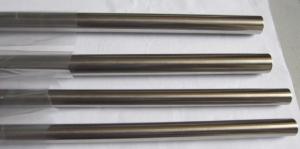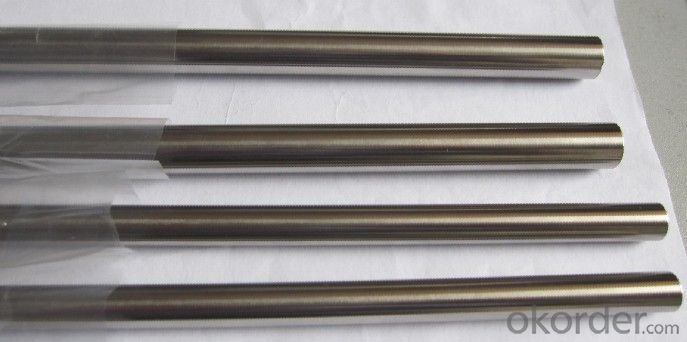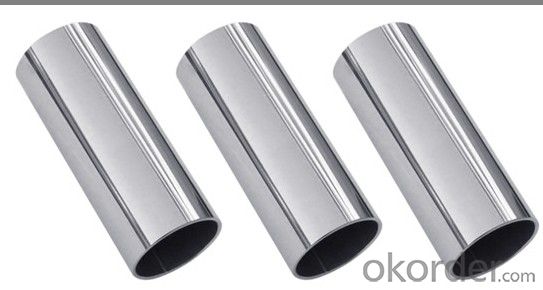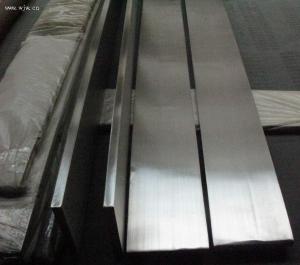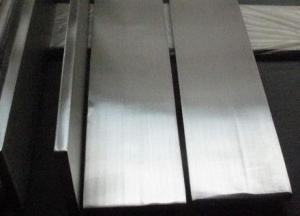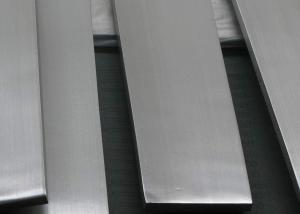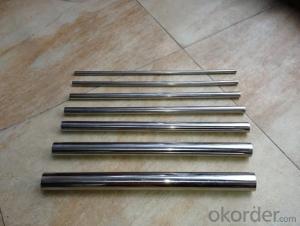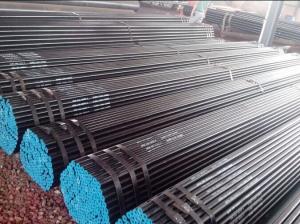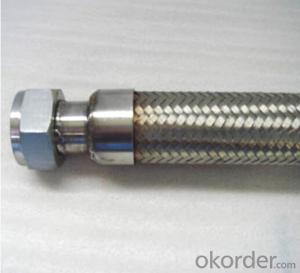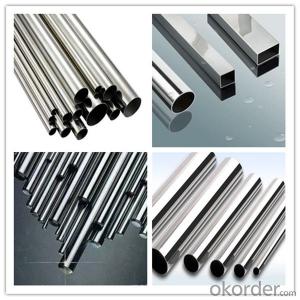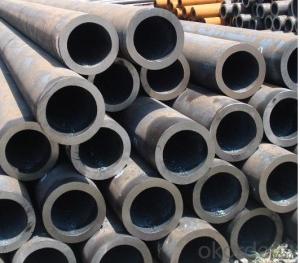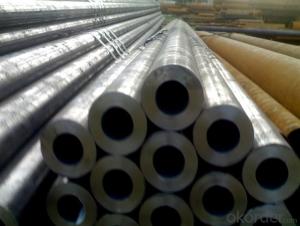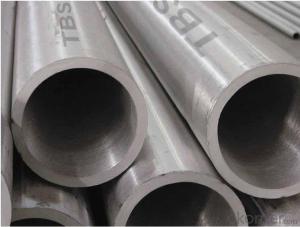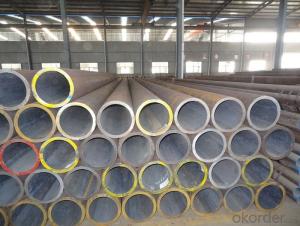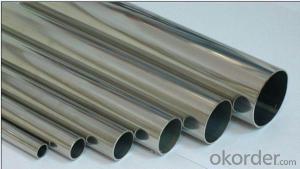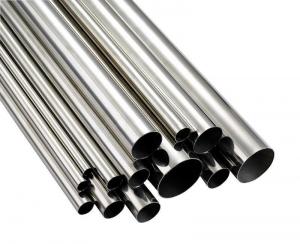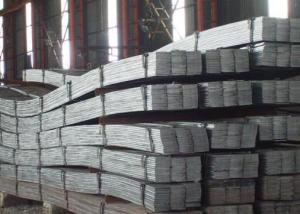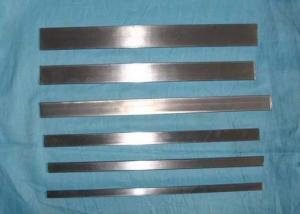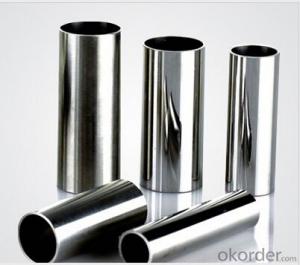A335 Seamless Ferritic Alloy-Steel Pipe for High-Temperature Service
- Loading Port:
- Shanghai
- Payment Terms:
- TT OR LC
- Min Order Qty:
- 1000 kg
- Supply Capability:
- 10000 kg/month
OKorder Service Pledge
OKorder Financial Service
You Might Also Like
(1) nominal wall and minimum wall seamless ferritic alloy-steel pipe intended for high-temperature service. Pipe ordered to this specification shall be suitable for bending, flanging (vanstoning), and similar forming operations, and for fusion welding.
(2)Each length of pipe is subjected to the hydrostatic test and examined by a non-destructive examination method in accordance to the required practices. The range of pipe sizes that may be examined by each method is subjected to the limitations in the scope of the respective practices. The different mechanical test requirements for pipes has been passed.
(3)Ferritic steels are defined as low- and intermediate-alloy steels containing up to and including 10 % chromium.
ASTM A335 Seamless Alloy-Steel Pipe
Standard: BS 1139, BS 3059-2, JIS G3454-2007
Grade: 10#-45#, 15NiCuMoNb5, 10Cr9Mo1VNb
Detailed introduction to ASTM A335 seamless alloy steel pipe:
ASTM A335 seamless alloy steel pipe


FAQ:
1) why you chose us ?
Professional Manufacturer and supplier of Steel pipe
More than 14 years’ professional producing experience
We can get the lowest ex-factory prices. The price are quite reasonable and it is lower than our commercial peers. also, we can guarantee the qualities of our products.
BV, ISO certificates and SGS test can be provided to assure the quality of our products.
2) Our minimum order quantity:
10 Metric Tons or one 20ft or 40ft Container.
3) How about the Delivery Time?
The steel pipe will be produced since we getting your deposit by T/T or Your original L/C. For normal size, some stocks in our factory now, we can supply once you need.
4)What kind of payment does your company support?
T/T, 100% L/C at sight, Cash, Western Union are all accepted.
5) Do you charge for the samples?
According to our company principle, we just charge for samples, you pay for the freight /courier charge.
6) Main market:
Mid East, South America, Africa, Southeast Asia, India etc
- Q: What is the difference between seamless and LSAW stainless steel pipes?
- Different industries commonly use seamless and LSAW stainless steel pipes. The manufacturing process and resulting structural characteristics distinguish these two types of pipes. Seamless stainless steel pipes are produced without any seams or welds. Manufacturers achieve this by piercing a solid cylindrical billet and extruding it to create a hollow tube. This technique ensures a uniform cross-section, resulting in a smooth and consistent inner and outer surface. The absence of welds eliminates potential weak points, enhancing the overall strength and integrity of the pipe. Seamless pipes are known for their superior corrosion resistance and are often preferred in critical applications where leakage must be avoided. In contrast, LSAW stainless steel pipes are formed by bending and welding a steel plate or coil into a cylindrical shape. The welding process involves passing an electric arc through the steel plate and the welding filler material, creating a visible seam on the pipe's exterior. LSAW pipes are commonly used in applications requiring large diameters and thick walls, such as oil and gas transportation. They can be produced in longer lengths and with larger diameters compared to seamless pipes. Seamless stainless steel pipes are generally more expensive to manufacture than LSAW pipes due to their complex production process. However, their seamless construction offers superior performance and reliability, making them the preferred choice for critical applications. On the other hand, LSAW pipes provide a cost-effective solution for large-scale projects where the visible seam is not a concern. To summarize, the main differences between seamless and LSAW stainless steel pipes lie in their manufacturing process, structural characteristics, and cost. Seamless pipes are made without seams or welds, providing excellent corrosion resistance and strength. LSAW pipes, on the other hand, are created by bending and welding a steel plate, offering a cost-effective solution for large-scale projects. The choice between these two types of pipes depends on the specific requirements of the application and the desired balance between cost and performance.
- Q: What is the difference between seamless and HFW stainless steel pipes?
- Seamless and HFW (High Frequency Welded) stainless steel pipes differ in their manufacturing process and the presence of a welded seam. Seamless stainless steel pipes are produced by piercing a solid billet or ingot and then rolling it into a cylindrical shape. This process eliminates the need for any welding, resulting in a pipe without any seams or joints. The absence of a welded seam enhances the overall strength and integrity of the pipe, making it ideal for high-pressure applications. On the other hand, HFW stainless steel pipes are created by using high-frequency electric resistance welding. In this process, a flat strip of stainless steel is passed through a series of rollers and then welded longitudinally using a high-frequency current. The welded seam is then heat-treated to ensure the same corrosion resistance as the base material. HFW pipes are generally more cost-effective compared to seamless pipes, making them a popular choice for various applications. While both seamless and HFW stainless steel pipes offer excellent corrosion resistance and durability, seamless pipes are often preferred in critical applications where high strength and reliability are crucial. The absence of a welded seam minimizes the risk of leakage and failure, making them suitable for industries such as oil and gas, petrochemical, and nuclear power. HFW stainless steel pipes, on the other hand, are more commonly used in less demanding applications such as water supply, plumbing, and construction. They provide a cost-effective solution without compromising the overall performance and corrosion resistance. In summary, the main difference between seamless and HFW stainless steel pipes lies in their manufacturing process and the presence of a welded seam. Seamless pipes are produced without any welding, offering superior strength and reliability for critical applications. HFW pipes, on the other hand, are manufactured through high-frequency electric resistance welding and are more cost-effective, making them suitable for less demanding applications.
- Q: Can stainless steel pipes be used for chemical reactors?
- Yes, stainless steel pipes can be used for chemical reactors. Stainless steel is known for its excellent corrosion resistance and durability, making it suitable for handling various chemicals and maintaining the integrity of the reactor system.
- Q: What is the difference between 321 and 316 stainless steel pipes?
- The main difference between 321 and 316 stainless steel pipes lies in their composition and applications. 321 stainless steel contains titanium, which helps improve its resistance to intergranular corrosion and high temperatures, making it suitable for applications in the aerospace and automotive industries. On the other hand, 316 stainless steel is more corrosion-resistant overall and is commonly used in marine environments or for applications involving exposure to chemicals or saltwater.
- Q: What is the difference between 304LN and 316LN stainless steel pipes?
- The main difference between 304LN and 316LN stainless steel pipes lies in their chemical composition and corrosion resistance properties. 304LN stainless steel pipes contain a higher percentage of chromium and nickel, making them more resistant to corrosion in general applications. On the other hand, 316LN stainless steel pipes have a higher content of molybdenum, which enhances their resistance to pitting and crevice corrosion, especially in chloride environments. Therefore, 316LN stainless steel pipes are often preferred in more corrosive and aggressive environments, such as marine or coastal applications, while 304LN stainless steel pipes are suitable for regular industrial and commercial use.
- Q: Can stainless steel pipes be used in extreme weather conditions?
- Yes, stainless steel pipes can be used in extreme weather conditions. Stainless steel is known for its excellent corrosion resistance, which makes it ideal for withstanding harsh weather conditions such as extreme temperatures, high humidity, and exposure to saltwater or chemicals. Additionally, stainless steel pipes have high strength and durability, making them resistant to impact and deformation caused by extreme weather events like storms or earthquakes. Therefore, stainless steel pipes are often chosen for applications in industries such as oil and gas, chemical processing, and marine, where they need to perform reliably in extreme weather conditions.
- Q: Are stainless steel pipes suitable for food processing industries?
- Yes, stainless steel pipes are highly suitable for food processing industries. Stainless steel is a preferred material in these industries due to its excellent corrosion resistance, durability, and hygiene properties. Stainless steel pipes do not react with food or alter its taste, and they are resistant to staining, rusting, and chemical damage. This makes them ideal for transporting various food products, including liquids, gases, and solids. Additionally, stainless steel pipes are easy to clean and maintain, reducing the risk of contamination and ensuring food safety.
- Q: What is the chemical composition of stainless steel pipes?
- Stainless steel pipes are primarily composed of iron, chromium, and varying amounts of other elements depending on the specific grade or type of stainless steel. The main component is iron, which provides the structural strength and durability. Chromium is the key element that gives stainless steel its corrosion-resistant properties. It forms a thin, passive layer on the surface of the steel, protecting it from oxidation and rust. Other elements commonly found in stainless steel pipes include nickel, molybdenum, and manganese, which further enhance its corrosion resistance, strength, and other specific properties. The specific chemical composition of stainless steel pipes can vary widely depending on the grade and intended application, allowing for different levels of strength, corrosion resistance, and heat resistance.
- Q: Can stainless steel pipes be insulated with polyethylene-co-vinyl acetate?
- Indeed, it is possible to insulate stainless steel pipes with polyethylene-co-vinyl acetate (PEVA). PEVA is widely utilized as an insulating substance owing to its remarkable thermal insulation characteristics. This material is both flexible and long-lasting, allowing for easy application to stainless steel pipes for insulation objectives. PEVA insulation contributes to the prevention of heat loss or gain, diminishes energy consumption, and furnishes protection against condensation. Furthermore, PEVA exhibits resistance against moisture, chemicals, and UV radiation, rendering it suitable for outdoor applications. Consequently, employing PEVA as insulation for stainless steel pipes presents a feasible alternative.
- Q: Stainless steel tube, also known as why tube?
- Use can be divided into oil well pipe (casing, tubing and drill pipe etc.), line pipe, boiler tube, mechanical structure, hydraulic prop pipe pipe, cylinder pipe, geological pipe, chemical pipe (high pressure fertilizer pipe, oil cracking tube) and shipbuilding pipe etc.
Send your message to us
A335 Seamless Ferritic Alloy-Steel Pipe for High-Temperature Service
- Loading Port:
- Shanghai
- Payment Terms:
- TT OR LC
- Min Order Qty:
- 1000 kg
- Supply Capability:
- 10000 kg/month
OKorder Service Pledge
OKorder Financial Service
Similar products
Hot products
Hot Searches
Related keywords
